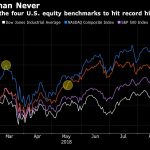Following the Fed’s failure to hike interest rates last week, the markets have been unable to gain any traction as the economic data continues to undermine the Fed’s conviction of improving economic strength.

But it is not just current economic data that is the problem, but the ongoing economic malaise that has been fostered by an excessively long period of near-zero interest rates. While lowering interest rates in the short-term does support economic activity, excessively low rates for a long-period divert productive capital into malinvestments. This was a point I addressed earlier this week with respect to Jamie Dimon’s misguided view of the economy. To wit:
“Of course, for the banks, Wall Street, private equity funds and all variations of capital markets, it has been an “economic nirvana.” The massive infusions of capital by the Federal Reserve have flooded the financial system driving asset prices higher and forcing a misallocation of capital into increasingly risky assets. While the U.S. may indeed be “number one” for financial engineering in all forms, it is rooted in a deeply artificial foundation that will eventually disintegrate into the next financial crisis.
But while financial engineering and venture capital may be juicing the profitability and wealth of a vastly small number of the total population, it is not driving the entrepreneurship needed to spark real economic growth. As noted by Gallup:
“The U.S. now ranks not first, not second, not third, but 12th among developed nations in terms of business startup activity. Countries such as Hungary, Denmark, Finland, New Zealand, Sweden, Israel and Italy all have higher startup rates than America does….and this is our single most serious economic problem...for the first time in 35 years, American business deaths now outnumber business births.”
The current surge in disinflationary pressures is not just due to the recent fall in oil prices, but rather a global epidemic of slowing economic growth. While Janet Yellen addressed this “disinflationary” wave during her post-meeting press conference, the Fed still maintains the illusion of confidence that economic growth will return shortly.

















Leave A Comment